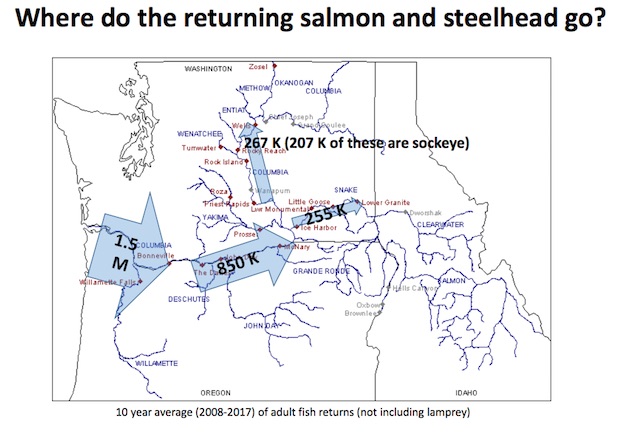forum
library
tutorial
contact

Fish Counts Vary at Bonneville Dam
by Matthew WeaverCapital Press, November 29, 2017
|
the film forum library tutorial contact |

|
Fish Counts Vary at Bonneville Damby Matthew WeaverCapital Press, November 29, 2017 |
Numbers are higher than they were when the dam was constructed in the 1930s.
 STEVENSON, Wash. -- Some fish counts are down at Bonneville Dam this year, while others are up compared to the 10-year average.
STEVENSON, Wash. -- Some fish counts are down at Bonneville Dam this year, while others are up compared to the 10-year average.
"It's a complex reason, there's no one single thing," said Army Corps of Engineers park ranger Monty Biggs at the Bonneville Dam Visitor Center. "These salmon are affected by cumulative effects. All of it makes a difference."
Also, some species of salmon such as chinook and coho do not return to spawn every year, so the numbers vary.
Some of this year's counts are on the low end of the 10-year average ranges, Biggs said.
In the past few years, the dam had record chinook salmon numbers pass through, Biggs said. Last year, almost 800,000 chinook salmon came through the dam's fish ladder. The year before that, the Corps counted 1.2 million chinook salmon.
The construction of homes, wastewater and environmental impacts such as fire and ocean conditions all have an effect on fish, he said Tuesday.
In the last two years, an area of warm water off the mouth of the Columbia River, known as "the blob," has affected salmon numbers by reducing the amount of forage fish they have to eat, Biggs said.
But salmon numbers overall are higher than they were when the dam was constructed, Biggs said. In 1938, the first year the dam was in operation, the Corps counted 271,000 chinook salmon.
Hatcheries have added stock, but wild salmon stocks are also higher than when the dam was built, Biggs said.
He credited the increase to changes in environmental practices, with steps taken to restore salmon habitat, avoid polluting the river, regulations that keep logging operations away from productive streams and limits to avoid overfishing.
The dam was built to solve such problems as flooding and electricity needs and to ease river navigation. When it was constructed, fish ladders for salmon were installed because fishermen relied on the fish for their living and people relied on them for their food, Biggs said.
The Corps is required under the Endangered Species Act to ensure a 97 percent survival rate for fish transiting the dam. That legal mandate could change if the salmon stocks ever start to show a continuous decline, he said.
"We are invested in what happens with the salmon, because taking care of the salmon is the only way we can make electricity," Biggs said. "You just can't have one without the other."
Biggs spoke to members of a Washington Grain Commission wheat export tour.
learn more on topics covered in the film
see the video
read the script
learn the songs
discussion forum
